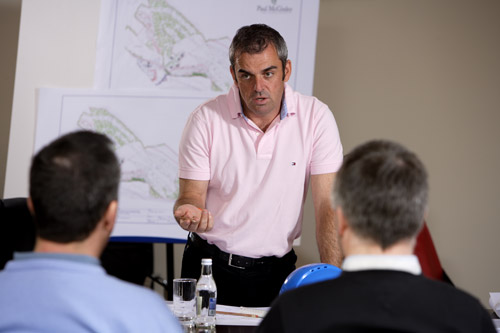Design
 Utilising 160 acres of Macreddin Valley, Ryder Cup hero, Paul McGinley chose this designated area of outstanding natural beauty for his first golf course design. Incorporating all the natural elements of the landscape, including statuesque pines, well protected greens, elevated landing areas and a free flowing brook, Paul drew on his years of experience on all the world’s leading courses to showcase his talents.
Utilising 160 acres of Macreddin Valley, Ryder Cup hero, Paul McGinley chose this designated area of outstanding natural beauty for his first golf course design. Incorporating all the natural elements of the landscape, including statuesque pines, well protected greens, elevated landing areas and a free flowing brook, Paul drew on his years of experience on all the world’s leading courses to showcase his talents.
McGinley in conjunction with his co-designer, the renowned Roger Jones, has produced a challenging and visually stimulating, Par 72, 7,173 yard undulating, golfing pilgrimage through the Wicklow countryside. He makes superb use of the natural forestation that provides wonderful definition.
The front nine sweeps eastward from the clubhouse. Mature tree-lined fairways synonymous to Macreddin Golf are evident from the opening holes. Panoramic views throughout the valley combined with meandering fairways between gentle slopes and natural contours of the terrain, epitomise the style and splendour of the first nine holes. Moving across the valley the back nine uses all of Macreddin's natural elements, including statuesque pines, well protected greens and elevated landing areas. The free flowing brook weaves its way through the back nine ensuring that decision making is an essential tool each golfer must carry.
"My passion for this project has propelled me to be more involved than I ever thought I would be - it's my first baby and it will always be a golf course I want to come back to. I have designed this course to be a very special golfing experience" – Paul McGinley
‘I’ve got very strong views on golf course design, probably stronger than on any other aspects of professional golf’
 So many so-called big-name golf course ‘designers’ pay lip-service to the detailed building of a golf course. They might turn up for the opening ceremony (more often than not to pick up a huge cheque) but they will rarely get their hands dirty and will not be able to speak in detail and with wisdom about why a course has been built the way it has. Worse still, they won’t have strong opinions about the philosophy behind golf course design.
So many so-called big-name golf course ‘designers’ pay lip-service to the detailed building of a golf course. They might turn up for the opening ceremony (more often than not to pick up a huge cheque) but they will rarely get their hands dirty and will not be able to speak in detail and with wisdom about why a course has been built the way it has. Worse still, they won’t have strong opinions about the philosophy behind golf course design.
Paul McGinley is NOT such a designer. His first course, Macreddin, is about to open in County Wicklow, an hour south of Dublin. And the Irishman recently talked to Golf World about the design philosophies behind his first work of art.
“I’m really not a fan of many new, modern courses, the sort which are 7,500 yards long. Look at Augusta National now. I don’t think the changes they’ve made there have made it a better golf course and it’s certainly not as enjoyable a tournament to watch as it was in the past. I also hate to see the massive tiers in greens you get at so many modern courses, huge elephants buried under the putting surfaces. I much prefer subtle areas, little tongues in greens. Putting surfaces should seldom be round, but instead be tongues, so that you can hide the flags in behind bunkers or behind slopes.
“I like as few blind shots as possible. I’ll do everything I can, even moving massive hills, to make a shot less blind. I hate hitting over a hill only to find there’s a water hazard lurking, which I didn’t know anything about.
“I love run-off areas. I love Pinehurst No2; in fact it’s my favourite course in America. It can be incredibly severe, but strategy is always to the fore. You have to plan your way around that place, and that’s the way golf was meant to be played. When you do hit it into the run-off areas at Pinehurst, you don’t just reach for your lob-wedge, as you would at most US Opens; you’ve usually got options to play six or seven different clubs. You should never, in golf, be forced to play one shot. You should always have options.
“The real key to making golf courses work for professional tournaments is to make the greens firm. If you don’t do this, you get a situation like at the US PGA Championship last year, when Tiger nearly got to 20-under on the longest course in Major history. Why? Because the greens were soft. You see, professional golfers can control the ball when we hit it from A to B and it stops at B. But, if we hit it from A to B and it runs off to C, D and E, that’s when we’re out of control.
“Firm greens also reward you for being on the fairway because it is only then that you can control your approach with spin. Look at Wentworth; it plays like two different courses in the BMW PGA Championship and the World Match Play Championship. When it’s dry, firm and fast in May then it’s tough; but people rip it apart in October when the greens are soft.
“I like to see golf played the way it was meant to be played; using imagination and shaping the ball into the pins. Imagination is so important in golf and plays a big role at my three favourite courses – Sunningdale, Royal Portrush and County Louth (Baltray).
The par-3s at Baltray are as good as you’ll get anywhere and are so reminiscent of Pinehurst. They are not long, but if you miss the putting area you can be in big trouble.
“That’s another thing I hate about modern designs; 250-yard par 3s. Look at the shortest hole on the Open rota, the Postage Stamp at Royal Troon. It’s without doubt one of the greatest par-3s in the game and that’s all
of designing it for a golfer. They have thought about the design and shape of the green and the design of the bunkers.
“I’ve tried to put all of these thoughts into Macreddin, a project in which I got more involved than I’d intended (to the detriment of my game). You don’t get a second chance to make a first impression, so I’m delighted to get the opportunity to work on such a spectacular piece of Irish landscape; with its rolling terrain, meandering brook and mature woodland.
“I don’t like intimidation for the amateur and at Macreddin I’ve tried to get as far away from that as possible. I don’t want big carries over water or over bunkers. I don’t want bunkers that are too deep. I always try and let amateurs have a run-off area so that whether it’s a little old lady or a professional playing the course, they have options.”

